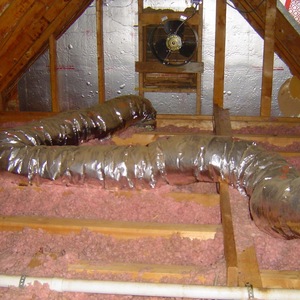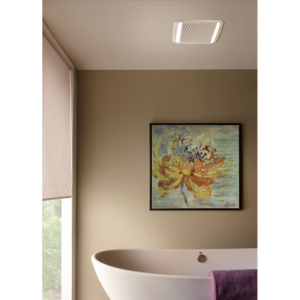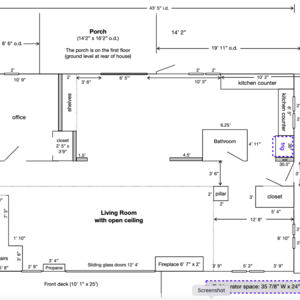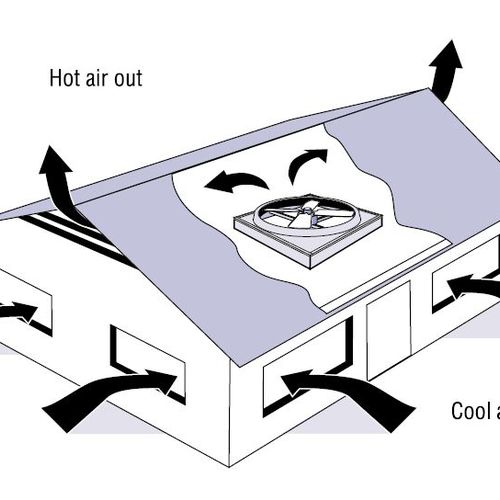
Writing from St. Paul, Minnesota, W Ramsay wants some feedback on his plan to install whole-house ventilation fans in the house he’s building. He likes the idea, the building inspector does not.
Ramsay sees the benefits of improved indoor air quality and energy-efficient cooling, while the inspector is apparently concerned that the fans would depressurize the house and possibly lead to backdrafting of combustion appliances.
Originally, the inspector was prepared to require a 1:1 makeup air system, which would not only be expensive but also defeat the purpose of the fans, Ramsay says. The inspector backed off that original request as long as Ramsay could guarantee that a sufficient number of windows would be open while the fan was running. More recently, the inspector says he wants an engineer to guarantee there would be enough passive makeup air for the system.
“Is a whole-house fan beneficial?” Ramsay asks. “To me this is a very easy ‘yes.’ On some days we can get enough air through our house with natural breeze, but many days there is either not enough breeze or it is coming from the wrong direction.
Weekly Newsletter
Get building science and energy efficiency advice, plus special offers, in your inbox.
“A whole-house fan creates the breeze and with windows open provides fresh air, reduces or eliminates VOCs and CO2, and cools the house for a lot [less] energy and dollars than running the AC,” he adds. “Am I nuts?”
Further, Ramsay wonders whether a whole-house fan could be considered dangerous. He says he found one instance in which a whole-house fan had been linked to a death; the victim was a high school student who turned on a fan after smoking marijuana but didn’t open any windows.
Are any of these concerns well-founded? That’s where we start this Q&A Spotlight.
Whole-house fans are great
“What’s not to like?” asks…

This article is only available to GBA Prime Members
Sign up for a free trial and get instant access to this article as well as GBA’s complete library of premium articles and construction details.
Start Free TrialAlready a member? Log in
















16 Comments
I suspect the cost of an attic fan installation would pay for a lot of electricity to run your standard AC with, or as has been suggested, a small solar array to offset the home’s electricity bill.
When all aspects and options are considered, I would be surprised if an attic fan makes sense in anything other than very specific climates.
I live near Denver and have a whole house fan. No matter how many windows I open, it ALWAYS trips off the furnace back-draft sensor if both the fan and furnace are running at the same time. I simply turn off the furnace before starting the fan. (The only time this is an issue is when we're trying to clear smoke from cooking.)
Costs vs benefits are definitely location dependent. Here in the Mid-Atlantic the shoulder months are too unpredictable to guarantee an overnight benefit from whole house fans so the benefit here is too slim.
One other point - I'm very surprised that there has been no mention of home security. We do not live in a high crime area but are constantly being advised by local law enforcement to keep our windows and doors locked overnight to prevent home invasion. I would think the only way a whole house fan could be used without jeopardizing home safety is if there were bars installed on all the windows you intend to open (which would then add additional costs and jeopardize emergency egress). Seems like a losing proposition.
I think that the whole house fan can be a energy benefit, but there must be an insulated box installed over the fan when not in use to reduce heat losses. The 3 ft hole in the ceiling will allow heavy heat losses as the only thing keeping the heat in the house from rising thru the opening are the thin aluminum flaps..
I always recommend building a box with rigid foam insulation on the inside, hinged at one side & a rope & pulley at the other side to raise & lower the box with the rope from a hallway closet when you want to use or turn off the fan.
As a Building Scientist that specializes in Deep Energy Retrofits, my company takes out whole house fans and then we properly air seal the attic to separate it from the house, then insulate to a minimum of R44 at the attic floor, or move the insulation to the roof rafters (dense pack via BIBS) and make the attic conditioned space. All while checking our work and progress with a blower door for best practices.
The reason for this is to stop the heat from coming into the house in the first place.
STOP PUTTING BANDAIDS ON A BULLET WOUND.
Building Science is not BS, it is proving your work is done right.
If you follow your ASHRAE 62.2 Residential requirements, and properly air seal and insulate to required depths, whole house fans become a myth. Just add your required balanced HRV's and you will stay comfortable year-round.
PS- Make sure your HVAC is a sealed system and Manual J on the design and it is amazing that your theory on Whole House Fans go Bye Bye.
"follow your ASHRAE 62.2 Residential requirements, and properly air seal and insulate to required depths, whole house fans become a myth"
OMG. . . Goodness. Do you you have a wife? Have you ever come across someone who simply cannot stand to be cooped up in a closed box all day and wants. . . get this: FRESH AIR!
We live in the country, in Minnesota. Our need for fully conditioned air, as in AC, is limited to a few, often, continuous weeks in late June / July-- 4 max. From the time the ice goes off till frost is on the pumpkins we have a varied number of windows open. When AC is required I finally do, in fact, shut all the windows and run the Mini-split. Otherwise, windows are open and importantly early evening and up to about midnight we run the 700 cfm exhaust fan in the kitchen to emulate a whole house fan.
New home 2017; I got around the BS from the local inspector whining about a whole house fan by simply roughing in the access port in the ceiling but have plans to eventually install a Tamarack WHF which DOES have R60 insulation covers for shutting over the winter. This may never happen because even with the severe under-rating of the kitchen exhaust we mostly are covered for needs of COOL fresh air. In this situation, with our boiler / water heater system having ducted in combustion air, there is NO reason why a whole house fan is not a savings over AC. We save MANY weeks of AC and cost of fresh air filters by using this simple method.
Some of you folks on this "forum" are just too zealous while not considering human reality.
What do you do when you go camping by the way? How is it possible for you to live? Will you be requiring Kelty and Northface tents to install CO2 sensors, makeup air, and particle sensing along with complying with ASHRAE 62.2 Residential requirements?!
Unless you absolutely have to have that open window breeze and need to hear birds chirping, and ERV/HRV will provide your house with all the fresh air you need. As an added bonus, the air will actually be cleaner, too, as it's filtered as it's drawn in. Oh, and you can still open a window in a house with no Whole House Fan, so it's not like you have to have one to experience that open window feeling.
Do you plan to have AC as well as a WHF? If so, the cost of installing both is pretty high and the added cost of the WHF could pay for many years of AC. As mentioned in the article, putting a small solar array in place instead of the WHF would not only cover your AC costs, but pay for itself over time.
Another drawback with constantly opening your windows is the amount of DUST that gets in. When we open our windows for just one day, if there's a decent breeze blowing our entire freshly cleaned house is covered with a layer of dust. It's especially bad in the spring with all the pollen in the air. Some people don't see dust and/or are not bothered by it, but if you're opening your windows all the time it's surely there.
A WHF may be a great solution for you and your wife, but there are lots of reasons why they are not a good solution for everyone, and many places where the climate just makes them ineffective.
"...a cover plate for the attic fan switch having this warning would work: 'Do not operate this fan without first opening windows.'” I have an AirScape fan and see that there is only room for a 2" x 1/2" label on my cover plate, and I'm having trouble finding a custom label that size. Who makes them? Must I buy a label maker?
The house design is important. Growing up, our whole-house fan was in the ceiling of the attached garage. To operate, you opened the door to the garge and large windows in the house. It did an excellent job pulling air all the way through the house, and cooled down the attic. But importantly, when not in use there's minimal issue of losses through the fan opening, as the air seal is that door.
My current house has a mudroom separted from the conditioned space by an exterior door, in a climate that can definitely make use of a fan for significant portions of the year. My plan is to follow the same aproach by putting one in there.
Great idea Gary. I also grew up in a home with a whole house fan, built in 1961. Huge louvered fan assembly in the main hallway. Man, when that puppy turned on it was loud. Your home's solution with the fan mounted in the garage is really unique and interesting. Your plans for the present home sound valid too. GO FOR IT.
This is an interesting topic about WHFs that seems to be fraught with bad info. WHFs are probably the most efficient way of conditioning the house air of any other method. But it's a very conditional efficiency that depends on many things. First, it usually requires a climate that is not too humid in summer because otherwise you will just be bringing in latent heat when you operate it at night. But there are a lot of climates in the western part of the U.S that are compatible with that. And if you are in the humid eastern part of the U.S don't make the mistake of telling us westerners that WHFs are no good just because they are no good for you. Another part of the climate requirement is that it (this is just my own rule of thumb) gets down to at least around 65F at night in summer except for maybe a few days.
Second, it really helps to have a fairly tight and well insulated house, especially the more extreme the heat is in summer during the day. More moderate climates have a lesser requirement of "a pretty good house". Use your common sense to correlate how well built your house is to your use of a WHF and the climate it sits in. If you live in primarily a heating climate make sure you can seal up the duct for the WHF very tightly during the cold periods. Even in my cooling climate I temporarily install a sealed R-20 panel over the opening during winter. Contrary to popular belief thin louvered doors do not cause hot air to come down from the attic in summer. (Hot air rises, remember)
I finally got my DER on my house finished and have my own results on the first really hot day of the summer - it hit 100F yesterday. The house is by no means a passive house, just 2.25ACH50, dense packed 2x6 cellulose walls, and R-40 cellulose attic. (DO NOT use fiberglass in attic if you want to stop heat from migrating from it as allows too much air circulation!) It got down to 69F in the morning and gradually got to 77F by the time I was able to turn on the WHF. It was easily accommodated by me with the use of ceiling fans. I made the mistake of having a slightly underpowered WHF for my house size so I'm not quite able to get the house temp down to the lowest temperature reached during the night. Don't make the same mistake I made. I can live with it though. I'm a pretty happy camper.
A good, common sense approach. If night time lows are significantly lower than your desired indoor set temp and humidity is very low, a WHF could surely be a benefit especially in a well insulated and airtight house (and an ERV as you mention). Makes perfect sense.
The better the house is insulated and the more the windows are shaded from the sun, the less temperature rise you would expect to see throughout the day. Your dense-packed cellulose walls surely have some thermal mass effect as well, which would slow the progress of heat through the walls as the day warmed up.
Yeah, part of the retrofit was building a south side porch with an overhang. It works well to shield the rays during the hottest part of the day. I also like porches generally to hang out in during the not so hot times of the year.
I guess I need to add one more thing that is a conditional requirement to make a WHF effective. The whole thing is dependent on a tight structure that has a thermos bottle effect on temperatures. I got a CO2 detector for my home and even with just a 2.25ACH50 it quickly goes past 1000 PPM if there are any breathing creatures in the house. Bottom line: you need an ERV or an HRV. Without an AC unit bringing in fresh air an exhaust fan won't cut it. While it will bring in fresh air you will lose the whole thermos bottle effect. I went from a bathroom exhaust fan to an ERV. It was a necessity.
Whole house fans are one of the best products you can add in your home from a cooling, comfort and indoor air quality perspective. A/C can make up 60-80% of your utility bill during the warmer months of the year. Whole House fans have been study by a ton of different sources that say it is the most cost effective way to cool your home. It can also cut out up to 90% off your a/c related costs. UCLA did a study and conducted that a whole house fan can eliminate a/c in 12 of the 16 climate zones in California. The EPA states that homeowners are spending over 90% of there time in doors and that even in the most polluted metropolitan areas in the country. It also states it is still 2-5 times More polluted indoors compared to outdoor air. Whole house fans are a prescriptive requirement in all new homes in CA.
You can verify all this information on QuietCool’s website http://www.quietcoolsystems.com
They have all the related white papers on there website and more. They’re the leaders in ventilation.
I have another suggestion - I have a Air King 20" whole house window fan. I install this during the shoulder seasons. This is no box fan - it moves 2500 cfm on high. It mounts on screws left permanently in the widow frame. Ideally it would be installed in little used rooms like a guest room or dining room that face the back of the house.
With one of these in an upstairs window and a portable powerful fan dropped into a first floor window we get to move some serious air without cutting a hole in the attic.
Cons: It blocks a window, it is loud, I need to remove it during the off season. It vibrates, especially on high, until I tune it by shimming it.
Log in or become a member to post a comment.
Sign up Log in